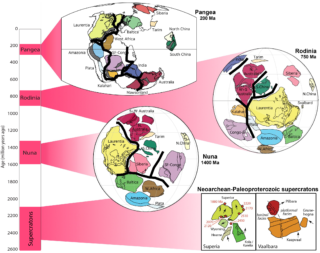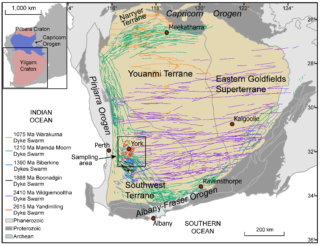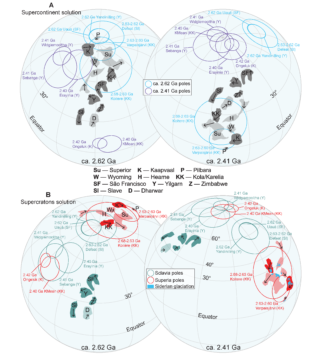It took 2 billion years for Earth to kick start its supercontinent cycle
Pangea (meaning “all earth”) was the first supercontinent scientists discovered early last century that existed some 300 million years ago and lasted until the dinosaur age. Because of plate tectonics, continents go from assembling together forming a supercontinent, to scattering about the globe.
In recent decades, geologists have realized that Pangea wasn’t a one-off occurrence. In fact, at least three supercontinents have formed over the past 2 billion years (Ga) of Earth’s history. Before Pangea there was Rodinia about 900 million years ago, and before that there was Nuna, about 1600 million years ago. But what happened in the first 2.5 billion years of Earth history is anybody’s guess.
In a new paper recently published in Geology, a team of researchers associated with Curtin University’s Earth Dynamics Research Group provide the first clues about the infancy of the supercontinent cycle in deeper time.
“There are two hypotheses we are trying to test here,” explains lead author Dr. Yebo Liu who was a Curtin PhD student when he started the research, but is now a postdoctoral fellow within the Curtin group. “One is that there was yet another older supercontinent and that the supercontinent cycle thus started more than 2 billion years ago.”
“The idea of an even older supercontinent has been speculated about for years. But while it has been difficult to prove, it has also been difficult to disprove,” explains Professor Ross Mitchell of the Chinese Academy of Sciences who was previously a member of the Curtin group. Before 2 billion years ago, Earth’s continental crust was so fundamentally different that the continents as we know them didn’t even yet exist.
“Each continent is actually comprised of 4 or so continental nuclei that formed over 2.5 billion years ago during the Archean Eon,” explains Liu. These ancient continental nuclei are called “cratons” for the strength they possess that allowed them to have lasted for so long. A pre-2 Ga supercontinent would have had almost all of the world’s cratons configured together. An alternative hypothesis, referred to as the supercratons hypothesis, posits that the cratons instead formed multiple clusters before 2 Ga that were geographically isolated from each other, never forming a singular supercontinent.

To conduct their test, the Curtin researchers ventured into the hills east of Perth in Western Australia, an area known as the Yilgarn craton. “Yilgarn was a critical piece of the puzzle not only because it is old, but also because there are a series of dark rocks — dolerite dykes — of the right ages”, says Liu. Some of these dykes have recently been discovered by the team, and the precise dating was done by a concurrent PhD student from the Curtin group, making them ideal and rare targets for palaeomagnetic analysis.

Palaeomagnetism is a discipline that involves retrieving fossil magnetic “needles” trapped in ancient rocks and use the signals to track the past motion history of tectonic plates. Liu and colleagues measured their oriented dyke samples using specialized facilities at Curtin.
By analyzing their new data from Yilgarn, and comparing it with the data available globally for other cratons, one thing became clear: “we can almost rule out the existence of a long-lived single supercontinent before 2 Ga. Instead, there could have been two ephemeral supercontinents at this time, which would stand in stark contrast to younger supercontinents that have been much longer lived”, explained Liu.

Alternatively, there could have been two long-lived clusters of cratons, or supercratons, before 2 Ga. “In either case, it appears that plate tectonics operated differently before 2 billion years ago, and the 600 million years supercontinent cycle likely only started during the second half or Earth’s life. That event marked a regime change in the Earth System, ranging from its core to its biosphere and atmosphere, including the emergence of complex life and even the formation and preservation of Earth resources”, explained Professor Zheng-Xiang Li, a co-author of the paper and head of the Earth Dynamics Research Group.
“This study surely isn’t the final word on the debate,” says Liu. “But it’s certainly a step in the right direction and we need to collect data from a lot more similar rocks to further test the hypotheses.”
Contact person: Dr Yebo Liu, Earth Dynamics Research Group, Curtin University.
Relevant publication:
Liu Y., Mitchell, R.N., Li, Z.X., Kirscher, U., Pisarevsky, S.A., Wang, C., 2021. Archean geodynamics: Ephemeral supercontinents or long-lived supercratons. Geology, 49(7), 794-798. https://doi.org/10.1130/G48575.1
Read the Curtin University Media Release:
Related articles:
Phys.org, Mirage News, The National Tribune, ScienceDaily, EurekAlert!, Science Codex, SciTechDaily, New Atlas, FocusTechnica, TerraDaily, The Nation, ámbito, notimérica
Podcast:
